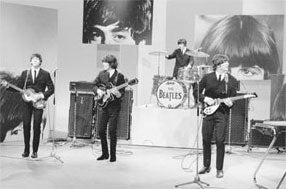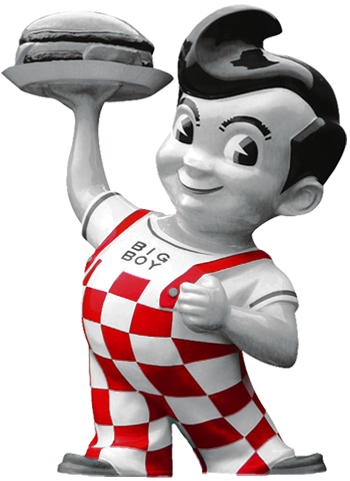History
This Bob's restaurant was built in 1949 by local residents Scott MacDonald and Ward Albert, and is the oldest remaining Bob’s Big Boy in America.

It was designed by renowned architect Wayne McAllister, incorporating the 1940's transitional design of streamline modern style while anticipating the free-form 50's coffee shop architecture.
The towering Bob's sign is an integral part of the building design and its most prominent feature. The restaurant was honored, receiving the designation as a "Point of Historical Interest" by the state of California.
More History
The current owner, the MacDonald Family, acquired control of the restaurant in 1993 and began to restore it to its past glory.
An exterior patio was added; the tower sign was rehabilitated; the dining room was remodeled; "Car Hop" service was re-introduced on Saturday and Sunday nights; and on Friday nights a “Classic Car Show” reverberates in the parking lot.
Many resources were spent to restore the quality of food, service, and hospitality which made Bob's a tradition and your meal the very best value in Southern California.
“The Bob's Big Boy and sign ensemble is significant to the history, culture, and architecture of Los Angeles and merits recognition and preservation.”Barbara A. Hoff of the LA Conservancy
The Big Boy® Story
In 1936, Bob Wian sold his car for $300 and bought a ten-stool lunch stand called "The Pantry." He then changed the name to "Bob's Pantry."

One late night, a regular customer asked for something "different." Bob split the bun twice through the middle, creating a middle bun, added two burger patties and the rest is history. The "Double-Deck Hamburger" was invented.
But the name came from a chubby 6-year-old doing odd jobs at the time by the name of Richard Woodruff. One day Bob forgot his name and called out "Hey, Big Boy." Something clicked and a name was born: Bob's Big Boy®
More Big Boy®
-

- Founder Bob Wian posing in front of Burbank's Big Boy
-

- Richard Woodruff, inspiration for the name "Big Boy"
"Everybody said, '(Bob Wian) you're nuts... leaving a good job to open a greasy spoon.'"Bob Wian on Buying The Pantry
Architecture
Bob's Big Boy in Burbank is a magnificent example of the emerging California coffee shop style that exploded in Los Angeles in the 1950's

It was designed by renowned architect Wayne McAllister, a leader in Googie architecture that embraced the automobile. Built in 1949, the structure is dramatically related to World Fair pavillions of the pre-war period by its long, low, horizontal roof line and wide canopies.
Its asymmetrical shape alternates from sharp angles at the entrance to smooth, inward curving picture windows facing the street.
Certainly the building's most striking aspect is the momumental freestanding Bob's sign which soars vertically in contrast with the horizontal lines of the restaurant. Placed at a strategic angle, the sign, with its attractive pink and white neon lettering, is breathtakingly dramatic and visible from far down Riverside Drive. The sign itself is transitional in that it is free standing and retains elements of the 1930's streamlining. The sign is a billboard raised to an art form. At 70 feet tall, the Bob's sign is a true landmark in the surrounding community. At night, with its dramatically lit sign and the wide band of windows highlighting the diners inside, the entire restaurant was a powerful lure to the passing motorist.
Abstract, amoebae-like canopies intersect the structure, metamorphosing into an angular skyward slanting entrance canopy. Various textures adorn the exterior walls from mosaic title to wooden clapboard to decorative vertical and horizontal brick veneer. Beautiful moss-green and black terrazzo walkways surround the building. A small, low-ceiling entrace way explodes into the large open space of the dining room.
Bob's interior has been remodeled several times but retains the original seating plan with booths strategically placed alongside the uniquely inward curving window wall so that customers have a panoramic view.
The restaurant, originally both a drive-in and sit-down restaurant, retains its drive-in features at the building's rear. The fully intact cantilevered, boomerang-shaped steel awning, reminiscent of Frank Lloyd Wright's Taliesen, covers what was originally drive-in parking.
The Beatles Booth
Famed British musical group The Beatles dined at the Burbank Bob's Big Boy location during the 1965 U.S. Summer Tour.

Their HELP album was released in the U.S. on August 13th of that year. Big hits included "Yesterday" and "Ticket to Ride."
Finding time after their second appearance on the Ed Sullivan Show and their landmark Shea Stadium concert, the FAB 4 requested to dine at a real American diner. Bob's Big Boy of Burbank was lucky enough to fill this need and be a part of Beatlemania.
Many regulars and tourists alike request "The Beatles Booth."
Don’t be suprised if it’s not available. Customers from around the world have waited hours to sit in the booth.
However, with over 5,000 square feet of dining space (including our outside patio) and seating capacity for 166 persons, we promise there’s plenty of delicious spots to enjoy a world famous Big Boy.
-

- Their 1965 appearance on the Ed Sullivan show
-

- Ed Sullivan with John, Paul, George and Ringo
"The table is the last booth on the right as one walks in, where the end of the windows facing out towards Riverside Drive stop. A plaque at the booth describes the event. The plaque has been stolen many times by fans (and has been replaced each time)."Mike Lopez of Bob's Big Boy Burbank
Filming Heat
Michael Mann filmed several key scenes of the 1995 American crime film Heat at Bob's Big Boy in Burbank.

Starring Val Kilmer (pictured), Robert DeNiro (pictured), and Al Pacino, the film is widely-regarded as Mann's best known work and one of the greatest movies made about Los Angeles.
With location manager, Janice Polley, Mann was able to film at 85 real Los Angeles locations. Fewer than 10 had ever been filmed before. Bob's Big Boy in Burbank was lucky and honored to be a part of this Los Angeles film history.
More Heat
-

- "The crew" making their final preparations for the big heist
-

- "The driver" in the back parking lot of Bob's Big Boy
"It's not just an action picture... the dialog is complex enough to allow the characters to say what they're thinking."Roger Ebert of the Chicago Sun-Times
California #P779
In 1992, the Burbank Bob's Big Boy received the designation as a "Point of Historical Interest" by the state of California.

The building, the oldest Bob’s still in existence, is considered an excellent transitional example of 1940s Streamline Moderne architectural style melding toward the 1950s "coffee shop modern" endemic in Los Angeles.
Of Wayne McAllister, Alan Hess stated, “Los Angeles and Las Vegas would have been far drearier places without the architect’s work.” McAllister also built the Las Vegas Sands (home to Sinatra’s Rat Pack).
More Resources
-

- The 70-foot Bob's tower sign and restaurant
-

- The sweeping roof line and windows of Bob's Big Boy
"It's a very significant piece of Los Angeles' cultural and architectural history. The building is one of the few surviving examples of its style: California coffee shop modern."Peter Moruzzi of the LA Conservancy
